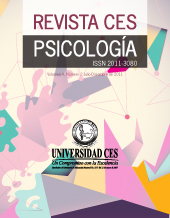Mobilities of young people from popular groups of Rio de Janeiro related to the streets and home
DOI:
https://doi.org/10.21615/cesp.13.1.4Keywords:
Youth, City, Mobility, Popular Groups, OpportunityAbstract
This work is focused on the experiences lived by young people from popular groups in Rio de Janeiro (Brazil) related to the street and home. It is highlighted a variety of dimensions that these spaces and time offer to young people, taking into account the aspects that limit or constraints their mobilities in these spaces, and also what is considered and opportunity for them. It was performed a qualitative study, involving a total of 51 young people, being students in elementary schools, from two public municipal schools of Rio de Janeiro, aged between 14 and 16 and residents in urban peripheries. Three discussion groups were carried out with these students, in addition to participant-observations in both schools. The data were analyzed using the Analysis of Content. The results show that young people meet innumerable limits to their mobility and face untimely situations in the street, which constitute what they call chaos. Given the negative unpredictability associated with street space, domestic space is valued, mainly for providing security that cannot be found in the street.
Downloads
References
Bardin, L. (2011). Análise de conteúdo. Lisboa: Editora 70. (Original publicado em 1977).
Borelli, S. H. S., & Rocha, R. M. (2008). Juventudes, midiatizações e nomadismos: a cidade como arena. Comunicação, mídia e consumo, 5(13), 27-40. doi: http://dx.doi.org/10.18568/cmc.v5i13.125
Cassab, C., & Mendes, J. T. N. (2011). “Perder-se também é caminho”: a dimensão espacial da juventude. Libertas On-line, 11(2), 1-18. Disponível em: https://periodicos.ufjf.br/index.php/libertas/article/view/18127/9379
Cassab, M. A. T. (2001). Jovens pobres e a cidade: a construção da subjetividade na desigualdade. In L. R. Castro (Ed.), Crianças e jovens na construção da cultura (pp. 209-226). Rio de Janeiro: NAU Editora; FAPERJ.
Cassab, M. A. T., & Reis, J. R. (2009). Juventude e cidade: um debate sobre regulação do território. Revista Praia Vermelha, 19(2), 143-154. Disponível em: https://revistas.ufrj.br/index.php/praiavermelha/issue/viewIssue/750/260
Cassab, M. A. T., Ribeiro, L. C., & Schettino, P. (2005). Desigualdade social e território: uma breve reflexão. Anais da II Jornada Internacional de Políticas Públicas. São Luís. Disponível em: http://www.joinpp.ufma.br/jornadas/joinppII/pagina_PGPP/Trabalhos2/Maria_Aparecida_Luiz_Claudio_Priscila297.pdf
Castro, L. R. (2004). A aventura urbana: crianças e jovens no Rio de Janeiro. Rio de Janeiro: 7Letras.
Castro, L. R. (2013). O futuro da infância e outros escritos. Rio de Janeiro: 7Letras, Faperj.
Cecchetto, F. R., Muniz, J. O., & Monteiro, R. A. (2018). “Basta tá do lado”: a construção social do envolvido com o crime. Caderno CRH, 31(82), 99-116. doi: http://dx.doi.org/10.1590/s0103-49792018000100007
Chaves, M., Segura, R., Speroni, M., & Cingolani, J. (2017). Interdependencias múltiples y asimetrías entre géneros en experiencias de movilidad cotidiana en el corredor sur de la Región Metropolitana de Buenos Aires (Argentina). Revista Transporte y Territorio, 16, 41-67. Disponível em: http://revistascientificas.filo.uba.ar/index.php/rtt/article/view/3602/3297
Cresswell, T. (2010). Towards a politics of mobility. Environment and Planning D: Society and Space, 28, 17-31. doi: https://doi.org/10.1068/d11407
Dimenstein, M., Zamora, M. H., & Vilhena, J. (2004). Da vida dos jovens nas favelas cariocas: drogas, violência e confinamento. Revista do Departamento de Psicologia/UFF, 16(1), 23-40. Disponível em: https://www.researchgate.net/profile/Junia_Vilhena/publication/268924221_Da_vida_dos_jovens_nas_favelas_cariocas_Drogas_violencia_e_confinamento/links/547b259d0cf293e2da2d34f9/Da-vida-dos-jovens-nas-favelas-cariocas-Drogas-violencia-e-confinamento.pdf
Duarte, A. J. (2014). A periferia como lugar social dos jovens e o processo de escolarização. Revista Iniciação & Formação Docente, 1(1), 1-18. http://seer.uftm.edu.br/revistaeletronica/index.php/revistagedeles/article/view/944/844
Gough, K. (2008). Moving around: the social and spatial mobility of youth in Lusaka. Geografiska Annaler: Series B, Human Geography, 90(3), 243–255. doi: https://doi.org/10.1111/j.1468-0467.2008.290.x
Gough, K. V., & Franch, M. (2005). Spaces of the street: socio-spatial mobility and exclusion of youth in Recife. Children's Geographies, 3(2), 149-166. doi: https://doi.org/10.1080/14733280500161560
Kuster, E., & Pechman, R. (2014a). Apresentação. Intolerância e solidariedade: o chamado da cidade. In E. Kuster & R. Pechman (Eds.), O chamado da cidade: ensaios sobre a urbanidade (pp. 11-15). Belo Horizonte: Editora UFMG.
Kuster, E., & Pechman, R. (2014b). Também sem a feli(z) cidade se vive: um panorama dos encontros e desencontros pelas ruas das cidades contemporâneas. In E. Kuster & R. Pechman (Eds.), O chamado da cidade: ensaios sobre a urbanidade (pp. 187-212). Belo Horizonte: Editora UFMG.
Langevang, T., & Gough, K. V. (2009). Surviving through movement: the mobility of urban youth in Ghana. Social & Cultural Geography, 10(7), 741-756. doi: https://doi.org/10.1080/14649360903205116
Lannes-Fernandes, F. (2012). Os jovens da favela: reflexões sobre controle e contenção sócio-espacial dos párias urbanos no Rio de Janeiro. Convergencia, 19(59), 159-186. Disponível em: http://www.scielo.org.mx/scielo.php?script=sci_arttext&pid=S1405-14352012000200007
Medeiros, B. F. (2016). Apresentação. John Urry (1946-2016). Trama: Indústria Criativa em Revista, 1(1). Disponível em: http://revistaadmmade.estacio.br/index.php/trama/article/view/2273/Apresentacao
Nascimento, C. T. B. (2013). A casa, a rua, a escola: espaços de múltiplas práticas juvenis, Porto Alegre: Editora da UFRGS.
Pechamn, R. (2014). Quando Hannah Arendt vai à cidade e se encontra com Rubem Fonseca. Ou da cidade, da violência e da política. In E. Kuster & R. Pechman (Eds.), O chamado da cidade: ensaios sobre a urbanidade (pp. 17-46). Belo Horizonte: Editora UFMG.
Saraví, G. (2014). Youth experience of urban inequality: space, class, and gender in Mexico. In J. Wyn & H. Cahill (Eds.), Handbook of childhood and youth (pp. 503-515). Singapura: Springer.
Segura, R. (2017). Ciudad, barreras de acceso y orden urbano: reflexiones sobre juventud, desigualdad y espacio urbano. Revista Argentina de Estudios de Juventud, e16(11), 1-12. doi: https://doi.org/10.24215/18524907e016
Senkevics, A. S., & Carvalho, M. P. (2015). Casa, rua, escola: gênero e escolarização em setores populares urbanos. Cadernos de Pesquisa, 45(158), 944-968. doi: https://doi.org/10.1590/198053143364
Sheller, M. (2018). Theorising mobility justice. Tempo Social, 30(2), 17-34. doi: https://doi.org/10.11606/0103-2070.ts.2018.142763
Skelton, T. (2013). Young people’s urban im/mobilities: relationality and identity formation. Urban Studies, 50(3), 467-483. doi: https://doi.org/10.1177/0042098012468893
Tapia, S. A. (2018). “No me agrada viajar”. Moverse en la ciudad como desafío cotidiano para jóvenes de barrios populares de Buenos Aires. Última Década, 48, 201-233. doi: https://doi.org/10.4067/S0718-22362018000100201
Veloso, S., & Santiago, V. (2017). Ninguém entra, ninguém sai: mobilidade urbana e direito à cidade no Complexo do Alemão. Rio de Janeiro: Fundação Heinrich Böll. Disponível em: https://br.boell.org/sites/default/files/web_livro_ninguem_entra_ninguem_sai.pdf
Winton, A. (2005). Youth, gangs and violence: analysing the social and spatial mobility of young people in Guatemala City. Children's Geographies, 3(2), 167-184. doi: https://doi.org/10.1080/14733280500161537
Downloads
Published
How to Cite
Issue
Section
License
Copyright (c) 2019 CES Psicología

This work is licensed under a Creative Commons Attribution-NonCommercial-ShareAlike 4.0 International License.
Each manuscript is accompanied by a statement specifyingThat the materials are unpublished, that have not been previously published in printed formatElectronic and that they will not be presented to any other means before knowing the decision of the magazine. ThroughoutIn case, any previous publication, sea in printed or electronic form, must be made known to the editorial staffWriting The authors attach a signed statement stating that, and the manuscript is acceptedFor publication, the rights of reproduction are the exclusive property of the Journal CES Psychology.| Article metrics | |
|---|---|
| Abstract views | |
| Galley vies | |
| PDF Views | |
| HTML views | |
| Other views | |




